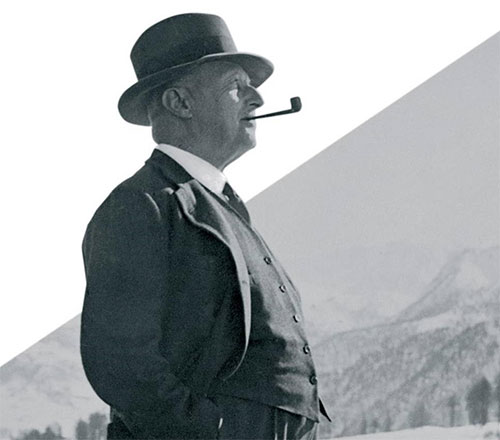 Our origins can be traced back to the end of the 19th century, and more precisely to 1899 when Giovanni Agnelli, a young cavalry officer, put his army career behind him in order to found Fabbrica Italiana Automobili Torino, FIAT, along with a group of other pioneers in the then nascent automobile industry.
Our origins can be traced back to the end of the 19th century, and more precisely to 1899 when Giovanni Agnelli, a young cavalry officer, put his army career behind him in order to found Fabbrica Italiana Automobili Torino, FIAT, along with a group of other pioneers in the then nascent automobile industry.
Over the ensuing decades Giovanni Agnelli laid the foundations of the family controlled entrepreneurial group that exists to this day. From the very beginning he was focused on three fundamental principles: technological innovation to drive the development of his industrial activities; an international outlook that embraced markets all around the world; and numerous new investments in sectors other than the automotive business.
During the first 20 years of the twentieth century, Giovanni Agnelli guided Fiat’s growth, principally in Europe and the United States; he encouraged the company to become involved in a range of international sporting competitions; he invested in the mechanisation of agriculture and public transport to accelerate Italy’s development as a modern industrialised nation. And in recognition of his entrepreneurial achievements he was awarded the highest honour the Italian parliament could bestow, hence he would thereafter become known simply as Il Senatore. In 1923 he acquired Juventus, a football club founded a few years earlier in Turin by a group of high school students: this marked the beginning of the longest uninterrupted ownership of any sports franchise anywhere in the world.
The most significant event in the our history other than the founding of Fiat, occurred as the 1920s drew to their close: in 1927 Il Senatore established IFI - Istituto Finanziario Industriale, a holding company that brought together and managed in an organised way the shareholdings in Fiat and in diverse other sectors: food (Cinzano), consumer goods (Società Anonima Manifattura Pellami e Calzature), financial services (Sava), airlines (Società Aviolinee Italiane), components and capital goods (RIV, Vetrocoke, Società Idroelettrica Piemontese-SIP), as well as a range of agricultural property and real estate investments (Sestriere). During the same period publishing became part of the our activities with the acquisition of La Stampa, one of the most storied Italian daily newspapers.
Industrial development and new acquisitions went hand in hand over the following two decades: Fiat’s output grew thanks to hugely successful cars such as the famous Topolino, heavy engines for the navy and a variety of models of planes, trains, tractors and lorries (“Earth, Sea and Sky”), while IFI acquired control of new companies in the food and cement sectors. This cycle of rapid expansion was abruptly interrupted by the world war.
Post war reconstruction triggered a cycle of new investments destined to transform all Europe. The Group’s structure developed with the acquisition of Istituto Commerciale Laniero Italiano (later renamed IFIL) and the establishment of IFINT in 1964 that brought together all its international investments. As Fiat became the symbol of the entire country’s modernisation, new industrial sectors were added to the automotive business, above all in Europe and the United States including in insurance, publishing and industrial components. In 1969 an agreement with Enzo Ferrari heralded the beginning of a partnership between two entrepreneurial families that saw the Prancing Horse grow to become the most admired and famous brand in the world.
Over the following decades many acquisitions were made, mainly in the United States, France and Italy. Those of Galbani and La Rinascente extended the Group’s presence in food and retail, while control of Toro strengthened its position in the insurance business, where a holding in Fireman’s Fund Co. in the US was also acquired. During the 1990s a number of world famous names featured in our portfolio including Chateaux Margaux, Club Méditerranée, Permal, the Parisian real estate of Societé Foncière Lyonnaise and the iconic Rockefeller Center in New York City. Towards the end of the decade IFINT acquired Exor Group and moved to extend its reach globally with investments also in Asia.
However the turn of the new century was marked by a deep crisis for Fiat, to which the Agnelli family – now into its fifth generation – responded with determination with a number of changes in leadership and injections of capital that made possible the relaunch of its industrial activities. The rejuvenation of the auto business led to the merger of Fiat with Chrysler which created a world leader in FCA. This was accompanied by a purposeful simplification of the Group’s structure. Exor became the sole holding company for all the controlled activities of the Group. Two transactions were particularly notable in this most recent chapter in our history: Exor acquired the entire share capital of PartnerRe, one of the world’s leading reinsurance companies. It also became the largest single shareholder of the publisher of the highly respected British weekly newspaper The Economist.
More than a century on from the founding in Fiat, the entrepreneurial spirit and financial discipline that has seen us build world leading companies are as alive and as strong as ever and continue to guide us in everything we do.
